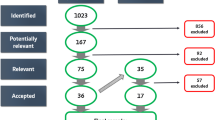Abstract
We use a quantile regression (QR) approach to analyse contingent valuation estimates of public willingness to pay (WTP) for the air and noise pollution reductions associated with the introduction of hydrogen buses in London. QR results show that variables that were not significant in interval regression or ordinary least squares regression become significant at certain quantiles along the WTP distribution. In addition, the determinants of WTP at the lower tail of the distribution differ from those at the higher end of the distribution. Our findings illustrate the usefulness of quantile regression methods for analysing contingent valuation data, enhancing our understanding of the determinants of willingness to pay.
Similar content being viewed by others
References
Adamowicz W., DeShazo J. R. (2006). Frontiers in Stated Preference Methods: An Introduction. Environmental and Resource Economics 34(1):1–6
Bassett G., Koenker R. (1982). Tests of Linear Hypotheses and L1 Estimation. Econometrica 50:1577–1583
Bateman I., Carson R. T., Day B., Hanemann M., Hanley N., Hett T., Jones-Lee M., Loomes G., Mourato S., Ozdemiroglu E., Pearce D. W., Sugden R., Swanson J. (2002). Economic Valuation with Stated Preference Techniques: A Manual. Edward Elgar, Cheltenham
Bateman I. J., Langford I. H., Turner R. K., Willis K. G., Garrod G. D. (1995). Elicitation and Truncation Effects in Contingent Valuation Studies. Ecological Economics 12(2):161–179
Bauer T.K., Haisken-DeNew J.P. (2001). Employer Learning and the Returns to Scholing. Labour Economics 8(2):161–180
Baur D., Saisana M., Schilze N. (2004). Modelling the Effects of Meteorological Variables on Ozone Concentration – A Quantile Regression Approach. Atmospheric Environment 38:4689–4699
Belluzzo W. J. (2004). Semiparametric Approaches to Welfare Evaluations in Binary Response Models. Journal of Business and Economics Statistics 22(3):322–330
Boxall P. C., Adamowicz W. L. (2002). Understanding Heterogeneous Preferences in Random Utility Models: A Latent Class Approach. Environmental and Resource Economics 23:421–446
Brouwer, R., I. J. Bateman, C. Saunders and I. H. Langford (1999), ‘Perception and Valuation of Risk Reduction as a Public and Private Good: Investigating Methodological Issues in Contingent Valuation of UV Risks in New Zealand’, CSERGE Working Paper GEC 99–06
Cameron T. A., Huppert D. D. (1989). OLS versus ML Estimation of Non-market Resource Values with Payment Card Interval Data. Journal of Environmental Economics and Management 17:230–246
Crooker J. R., Herriges J. A. (2004). Parametric and Semi-parametric Estimation of Willingness to Pay in the Dichotomous Choice Contingent Valuation Framework. Environmental and Resource Economics 27:451–480
Dougherty C. (2001) Introduction to Econometrics, 2nd edn. Oxford University Press, Oxford, UK
Garrod G., Willis K. (1999). Economic Valuation of the Environment: Methods and Case Studies. Edward Elgar, Cheltenham
Halstead J. M., Lindsay B. E., Brown C. M. (1991). Use of the Tobit Model in Contingent Valuation: Experimental Evidence from the Pemigewaset Wilderness Area. Journal of Environmental Management 33:79–89
Karlstrom M. (2005). Local Environmental Benefits of Fuel Cell Buses – A Case Study. Journal of Cleaner Production 13(7):679–685
Koenker, R. (2006), The Quantreg Package, Version 3.89, April 9th 2006, Available on: http://www.r-project.org
Koenker, R. (2003), Short Course on Quantile Regression, CEMMAP Master Class: Quantile Regression February 2003 (http://cemmap.ifs.org.uk/docs/koenker_mc_handout.pdf)
Koenker R. W., Bassett G. W. (1982). Robust Tests for Heteroscedasticity based on Regression Quantiles. Econometrica 50:43–61
Koenker R., Bassett G. (1978). Regression Quantiles. Econometrica 46:33–50
Koenker R., Hallock K. (2001). Quantile Regression. Journal of Economic Perspectives 15:143–156
Koenker R., Machado J. (1999). Goodness of Fit and Related Inference Processes for Quantile Regression. Journal of the American Statistical Association 94:1296–1310
Kordas, G. (2000), Binary regression quantiles. Ph.D. Dissertation, Ann Arbor: UMI Dissertaton Services
Li C. (1996). Semiparametric Estimation of the Binary Choice Model for Contingent Valuation. Land Economics 72(4):462–473
Long J. S., Freese J. (2006). Regression Models for Categorical and Limited Dependent Variables Using Stata, 2nd edn. Stata Press, College Station TX
Maddala G.S. (1999) Limited-dependent and Qualitative Variables in Econometrics. Cambridge University Press, Cambridge MA
Martins P.S., Pereira P.T. (2004). Does Education Reduce Wage Inequality? Quantile Regression Evidence from 16 Countries. Labour Economics 11(3):355–371
Mello M., Perrelli R. (2003). Growth Equations: A Quantile Regression Exploration. The Quarterly Review of Economics and Finance 43:643–667
Milon J. W., Scrogin D. (2006). Latent Preferences and Valuation of Wetland Ecosystem Restoration. Ecological Economics 56:162–175
Mitchell R. C., Carson R. T. (1989). Using Surveys to Value Public Goods: The Contingent Valuation Method. Resources for the Future, Washington
Morey E., Thacher J., Breffle W. (2006). Using Angler Characteristics and Attitudinal Data to Identify Environmental Preference Classes: A Latent-Class Model. Environmental and Resource Economics 34(1):91–115
Mourato, S., B. Saynor and D. Hart (2004), `Greening London's black cabs: a study of driver's preferences for fuel cell taxis', Energy Policy 32, 685–695
ONS (2004), in P. Causer and T. Williams, eds., Region in Figures: London, Summer edition. London: Office for National Statistics
Schimek P. (2001). Reducing Emissions from Transit Buses. Regional Science and Urban Economics 31:433–451
STATA (2006), ‘STATA Analysis Examples: Interval Regression’, UCLA Academic Technology Services, Available on: www.ats.ucla.edu/stat/stata/dae/intreg.htm
TfL (2002) London Travel Report, Transport for London. Downloadable on (www.tfl.gov.uk/londontravelreport)
Whitehead J., Hobant T., Clifford W. (1995). Measurement Issues with Iterated, Continuous/Interval Contingent Valuation Data. Journal of Environmental Management 43:129–139
Acknowledgements
We thank Roger Koenker, Peter Pearson, Paul Johnson, David Hart, two anonymous reviewers and the editor for very helpful comments. We also thank Tiago Neves for his data from the ACCEPTH2 project, as well as Lisa Garrity, Simon Whitehouse, Matthias Altmann, Cornelia Grasel and Anne Stevcevski for valuable collaboration in the design of the core questionnaire. Finally, we acknowledge financial support from the European Union under the ACCEPTH2 project (Contract No ENK5-CT-2002-80653) and from the John Stanley Studentship (for Tanya O’Garra).
Author information
Authors and Affiliations
Corresponding author
Rights and permissions
About this article
Cite this article
O’Garra, T., Mourato, S. Public Preferences for Hydrogen Buses: Comparing Interval Data, OLS and Quantile Regression Approaches. Environ Resource Econ 36, 389–411 (2007). https://doi.org/10.1007/s10640-006-9024-0
Received:
Accepted:
Published:
Issue Date:
DOI: https://doi.org/10.1007/s10640-006-9024-0




